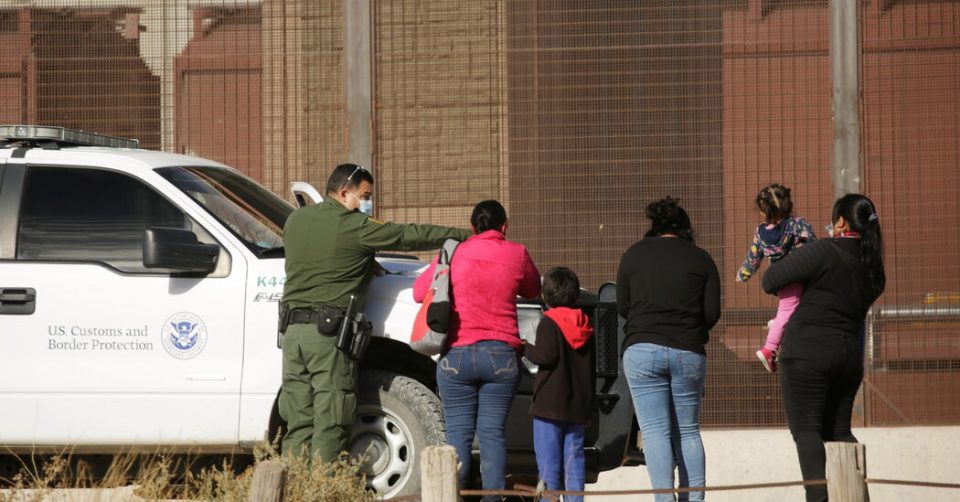
WASHINGTON — A Mexican law has stopped the United States from rapidly turning away migrant families at one of the busiest sections of the southwestern border, forcing agents to resume releasing families into the country, according to three Biden administration officials.
The Trump administration began turning back migrants entering the United States in March, citing the threat of the coronavirus, and the emergency rule effectively sealed the border from asylum seekers. But because of a law Mexico passed in November that prohibits the detention of immigrant children and families, the country has stopped accepting such families from South Texas, an area typically susceptible to illegal crossings, officials said.
The recent shift has alarmed officials at the Department of Homeland Security and presents an immediate challenge to the Biden administration. Homeland security officials have said the emergency rule was necessary to prevent the coronavirus from spreading in detention facilities along the border, even as it prevented vulnerable families from having their asylum claims heard. An increasing number of families have been held in recent weeks in such facilities in the Rio Grande Valley, as well as in Del Rio, Texas, officials said.
Stephanie Malin, a spokeswoman for Customs and Border Protection, said because of pandemic precautions and social distancing guidelines, some facilities had reached full “safe holding capacity.”
“C.B.P. takes very seriously the safety and well-being of its work force and those they encounter, and we are taking even more precautions due to Covid-19,” Ms. Malin said. “As they always have, the number of individuals crossing the border continues to fluctuate, and we continue to adapt accordingly.” She said the agency was working with organizations in the community when releasing migrants into the public.
The United States has expelled more than 390,000 migrants back to Mexico or their home countries since March. The rule lowered the number of migrants detained on the U.S. side of the border, but it also sent Central American families scrambling at times when they learned that their children had been delivered to Mexico, a violation of international agreements. And while the policy was a crucial piece of the Trump administration’s attempts to close the border to migrants, the rule also had the unintended effect of giving migrants more chances to enter illegally.
Customs and Border Protection recorded more than 73,000 crossings in December, an increase from the more than 40,000 in July. Agents detained more than 40,000 migrants in December 2019.
The Mexican law, which took effect in January, does not apply to the entire border, officials said. American border agents are still turning back single adults, and in places like Arizona, families, as well, officials said. It is unclear how the law will affect other parts of the border.
A spokesman for the Foreign Ministry in Mexico declined to comment on whether it had stopped accepting migrant families, saying only that the United States continued to have the pandemic emergency rule in place.
But the Biden administration has been unable to return migrant families to Reynosa, Mexico, a change that was first reported by The Washington Post. The shift has elicited concern at Customs and Border Protection of a potential rise of crossings by families to the neighboring Rio Grande Valley. Border crossings in recent years have been fueled mostly by Central American families fleeing persecution, violence and poverty.
The Department of Homeland Security is currently building a tent facility in Donna, Texas, to house migrants, but an administration official said that was unrelated to the law in Mexico. Customs and Border Protection said in November it would shut the main detention facility in McAllen for renovations.
President Biden campaigned on restoring asylum at the southwestern border and signed an executive order this week directing the administration to review rolling back President Donald J. Trump’s restrictionist policies.
The new administration has not detailed publicly when the pandemic emergency rule would be lifted. After a federal judge in the District of Columbia lifted a block on the rule, which prevented the United States from turning away unaccompanied migrant children, the White House said it would use its discretion in deciding when to apply the policy.
Mr. Biden said in December that his administration would take a cautious approach to reversing Trump-era policies to avoid a surge at the border.
His immigration plan involved relying more on programs that track migrants after they are released into the United States to ensure they show up for immigration court and less on detaining them.
Mexico, for its part, drew praise for enacting restrictions on who it detained.
“Mexico is making a decisive step to end immigration detention for children and we are encouraged by this promising development,” said Gillian Triggs, the assistant high commissioner for the United Nations High Commissioner for Refugees.
While top officials in the Trump administration argued its emergency rule was only an attempt to prevent the spread of the coronavirus, Mr. Trump’s White House tried to use the policy to further his goals of curtailing illegal immigration.
Kirk Semple contributed reporting from Mexico City.


